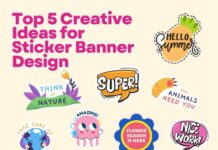Drawing is something We have always adored. We still remember scoring full marks in the drawing. It’s a way to express your feelings, creativity, or emotions and convey a message more effectively.
Nowadays, from designing wedding cards to online marketing campaigns, every sector leverages art & graphic design in their processes.
But why is that?
Because 80% of people remember visuals more than plain text. It injects creativity and transforms any simple content into something amazing.
That’s why you should understand the processes and techniques used in art and graphic design.

Whether you’re an experienced artist or a budding graphic designer, this detailed guide will help you understand all the complexities of art and design and how to become proficient in it.
Understanding Art & Graphic Design
We know you have some ideas about art and graphic design, but we’re going to explain this in simple terms so that you will understand how art and graphic design relate to each other.
Art refers to visuals that a user can create or draw. It consists of drawing, painting, and sculpture. People who draw art are recognized as artists. You can also generate art using art generators such as string art generator.

Have you heard about the famous painting of the Mona Lisa? What do you think? Is this art or graphic design?
It’s an art that was drawn by Leonardo da Vinci. Art is a form of visual art that is completely created by humans without the use of any software technology.
Graphic design is the field where professionals create visuals that communicate messages. It involves different processes and techniques, such as page layout, typography, and many other techniques.
You can draw art freely, but in the field of graphic design, you have to create designs that convey a message.
What is the difference between Art & Graphic Design?
Buckle up, because we’re about to untangle the web of confusion between these two!
Purpose
Art lets us create drawings freely to express something. This means that what you have in your mind, you can express with the help of the arts. In short, it showcases the artist’s vision and emotions.
Graphic design primarily aims to craft visuals that convey messages which further increases followers just like you can leverage Stream Oz to increase followers on Twitch platform. Professional designers use graphic design to create professional designs such as company logos, pamphlets, or other design materials.
Process
Art comprises drawing, painting, and creating shapes, lines, and pixel art ideas. The process behind art is artists’ emotions and their inspiration. Artists are free to follow any brief or instructions.
The process of graphic design is somewhat more complex than that in traditional art. It adheres to brief guidelines to create any visual design.
Techniques
Art does not have any special requirements, as you only need brushes, color, and paint to draw any art.
When talking about graphic design, one should need a few pieces of software to create prototypes and designs.
Key Principles of Art & Graphic Design
Art and graphic design both have one common goal: to create visuals that look compelling and attention-grabbing. As a professional working in the field of art and graphic design, here are some key principles We found common in both:
#1 Balance
It refers to the symmetry and asymmetry between design elements. To explain in a better way, let me give you one example:
Let’s say you are creating one visual and adding more than enough design elements. We know you think it looks good, but the visual balance mainly depends on the requirement. If the art or design has one or two color requirements, then overly designed visuals seem imbalanced.

#2 Contrast
Have you seen visuals that have dark or light colors? Contrast helps create any design element that looks different from others. By incorporating dark color, you can make that design element more compelling than the light color element.
#3 Emphasis
It refers to the art of using contrast in a way to draws the viewer’s attention to a specific design element. This principle mostly applies to areas where important things are highlighted in art & graphic design.

#4 Movement
We know what you are thinking when We say ‘movement.’ But here we are not talking about movable images or some kind of short clip. We are talking about designs that have made viewers move their eyes to the whole design. These include the use of some design elements, such as arrows.
#5 Pattern
It is the repetition of any design element, such as a line, shape, or anything. The main objective of this is to insert unity and rhythm into the design.

#6 Rhythm
It refers to the sense of movement created by the repetition of design elements such as lines and shapes.
#7 Unity
When you apply all the above design principles, you will see a coherence or wholesome feeling in your art and graphic design. This is referred to as unity.
Conclusion
In a nutshell, with continuously evolving technology, it’s important to create visuals that have the potential to mesmerize users.
With the art of practicing and continually applying the principles and techniques we discussed above in the article, you can become a great artist or graphic designer.
In my opinion, you can leverage art & graphic design skills in every field, whether personal or professional.
From using art to express your emotions to creating logos and designs for a brand, with the help of this skill, you can create compelling visuals.
FAQs About Art & Graphic Design
Q1. Is graphic design a form of art?
Ans. No. It’s not an art. Graphic design is the blend of art and technology to create compelling visuals that communicate with the user.
Q2. What is graphic art technique?
Ans. Graphic art is the technique used to create impactful visuals. It mostly comprises techniques such as drawings, photography, computer graphics, calligraphy, and typography.
Q3. What are the 7 basic principles of graphic design?
Ans. Here are 7 basic principles of graphic design:
- Balance
- Contrast
- Emphasize
- Movement
- Pattern
- Rhythm
- Unity
With proper incorporation of these principles, you can learn to create basic visuals.
Q4. How does art help with visual learning?
Ans. Art lets you draw complex information in the form of visuals such as infographics, flow charts, drawings, etc. These further look easy to understand, especially if you are a student.
READ MORE: The Future of Digital Empowerment in a Connected World
If you like our article, please subscribe to BsyBee Design for the latest updates on design. If we forget anything, share your creative ideas in the comments section.
Follow us on Facebook, Linkedin, Instagram, Pinterest and YouTube.


































